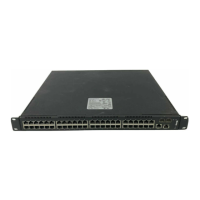Layer 2,3,IPv6+QoS Switch
_____________________________________________________________________________
Layer 2,3,IPv6+QoS Network Switch User Manual Version 0.1 Page: 442/970
of the neighbor, and when you specify this, detailed information about the neighbor displays.
The information below only displays if OSPF is enabled and the interface has a neighbor.
Syntax
show ip ospf neighbor [interface <slot/port>] [<ipaddr>]
<ipaddr> - IP address of the neighbor.
<slot/port> - Interface number.
Default Setting
None
Command Mode
Privileged Exec, User Exec
Display Messages
Interface Is the interface number.
Router Id Is a 4-digit dotted-decimal number identifying neighbor router.
Options An integer value that indicates the optional OSPF capabilities supported by the
neighbor. The neighbor's optional OSPF capabilities are also listed in its Hello packets.
This enables received Hello Packets to be rejected (i.e., neighbor relationships will
not even start to form) if there is a mismatch in certain crucial OSPF capabilities.
Router Priority Displays the OSPF priority for the specified interface. The priority of an
interface is a priority integer from 0 to 255. A value of '0' indicates that the router is not
eligible to become the designated router on this network.
State The types are:
Down- initial state of the neighbor conversation - no recent information has been received
from the neighbor.
Attempt - no recent information has been received from the neighbor but a more concerted
effort should be made to contact the neighbor.
Init - an Hello packet has recently been seen from the neighbor, but bi-directional
communication has not yet been established.
2 way - communication between the two routers is bi-directional.
Exchange start - the first step in creating an adjacency between the two neighboring routers,
the goal is to decide which router is the master and to decide upon the initial DD
sequence number.
Exchange - the router is describing its entire link state database by sending Database
Description packets to the neighbor.
Loading - Link State Request packets are sent to the neighbor asking for the more recent
LSAs that have been discovered (but not yet received) in the Exchange state.
Full - the neighboring routers are fully adjacent and they will now appear in router-LSAs and
network-LSAs.
Events The number of times this neighbor relationship has changed state, or an error has
occurred.
Permanence This variable displays the status of the entry, either dynamic or permanent.
This refers to how the neighbor became known.
Hellos Suppressed This indicates whether Hellos are being suppressed to the neighbor.
The types are enabled and disabled.
Retransmission Queue Length Is an integer representing the current length of the

